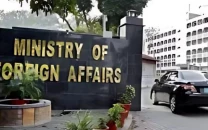[No] state of development: Neglected, exploited and ignored, rural areas of Pakistan still lagging behind
The SPDC annual report highlights indicators of economic and social repression in the country.

Despite a significant contribution of over 50 per cent to the GDP, Pakistan's rural areas lag far behind their urban counterparts in terms of social development. Extreme inequality exists in almost all sectors.
Almost 75 per cent rural population prefers to go to private hospitals and the enrolment in public schools has been witnessing an annual decrease of almost six per cent over the last few years.
"We must focus on pro-poor reforms," said economist Dr Hafiz A Pasha, during the launch of the annual review by Social Policy and Development Centre (SPDC), titled 'The State of Social Development in Rural Pakistan' at the Marriott hotel on Wednesday. Criticising the government and stakeholders for the lack of social development in rural areas and the way subsequent governments have dealt with the issues, Dr Pasha expressed his disappointment with the rural economic growth which according to him, is only two per cent.
"Just 13,000 landlords own around six million acres of agriculture land," he remarked. "This is the kind of disparity that exists in our country."
Enrolment in public schools has been falling by six per cent annually, he said. "What is happening here?" he asked incredulously. Public sector schools lack basic facilities such as washrooms and drinking water. "This is why people prefer to send their children to private schools," he explained. "This chaos is all because of the corruption of government officials. There are thousands of ghost schools and as many teachers on their payroll."

For Dr Pasha, the healthcare industry has not fared much better. "This country has behaved poorly with preventive healthcare," he said, referring to the number of polio cases and poor coverage of immunisation. "This is a classic example of the failure of the government. We should be ashamed of ourselves for the nation we have become."
The annual review is a comparative study that reflects how the social sector has fared, particularly after the promulgation of the 18th Amendment. It highlights urban-rural disparities in terms of population, demography, education and public health. Moreover, the report profiles and quantifies the rural economy and provides the latest estimates of poverty.

The economy
Contrary to common perception, the agricultural sector does not dominate the rural economy with a share of 38 per cent as compared to 41 per cent of the services sector. Interestingly, the share of rural areas in industrial activity is as high as 42 per cent.
With regards to income inequality, the study notes that per capita income in urban centres is 1.9 times the rural equivalent in the country. The province with the largest differential is Balochistan with a ratio of 3.3, followed by Sindh at 2, Punjab at 1.8 and Khyber Pakhtunkhwa at 1.6.
"The participation of females in the labour force is only 31 per cent as compared to 84 per cent for males," claimed Muhammad Asif Iqbal, the principal economist of the SPDC.
Iqbal, aided by graphs and tabulated results in the report, explained that an estimated 39 per cent of the rural population of Pakistan was living below the poverty line in 2011. Rural poverty is lowest in the Punjab and highest in Balochistan. The figures are almost equal in Sindh and Khyber-Pakhtunkhwa. "The income inequality has increased considerably during the last decade," he revealed. The rural poverty, 39 per cent, is significantly high. Social protection programmes, such as the Benazir Bhutto Income Support Programme, exist, albeit at a very low level.
He said that the ownership by the federal government, after the 18th Amendment, is missing.
Sustainable rural development
Water and land degradation are the most important issues in the way of sustainable development in Pakistan. Water availability on a per capita basis has been declining in the country at an alarming rate - from about 5,000 cubic metres per capita in 1951 to about 1,100 cubic meters at present.
Multiple factors are putting undue stress on water resources, including rapid urbanisation, increased industrial activity and dependency of the agricultural sector on chemicals and fertilisers.
For sustainable growth to be implemented, the SPDC report suggests environmental issues be thoroughly integrated within economic policies and institutional reforms.

State of education in rural Pakistan
The Constitution of Pakistan guarantees access to education for each child. After the 18th Amendment, this responsibility lies with the respective provincial governments. Article 25a of the Constitution says: “The State shall provide free and compulsory education to all children between the ages of 5-16 years in such manner as determined by law.”
The dilemma is that none of the representatives in the provincial assemblies have endeavoured to frame the necessary legislation that the Constitution refers to when it states ‘as determined by law’.
Overall, around 36 per cent [approximately 10 million] children of the primary age-group [5-9 years] were out of school in the year 2011. The lowest incidence [28.4 per cent, approximately 4 million] of out-of-school children is observed in Punjab. A relatively dismal picture is evident with reference to out-of-school children in rural Balochistan and Sindh where about half the children of primary age were not attending school.

SOURCE: SPDC ESTIMATES BASED ON HOUSEHOLD LEVEL DATA OF PSLM 2010-2011
Around 26 per cent of the children were out of school due to economic reasons. Moreover, around 32 per cent of the girls were out of school due to their parents’ refusal to send them to school.
The analysis in the report demonstrates that education of the family head directly and indirectly influences poverty levels. Female-headed households are also found to have a higher percentage of enrolment.
The gender disparity in terms of enrolment is quite high in rural Balochistan, where about 70 per cent girls in the 5-9 age groups were not attending school, against 45 per cent boys.
Overall, electricity is available in only 37 per cent primary schools, while 60 per cent primary schools operate in unsatisfactory condition of buildings. About 10 per cent primary schools in rural areas have no buildings whereas about 30 per cent run without boundary walls.
Literacy rates in rural Pakistan are 46 per cent for the overall rural population, with 60 per cent for males and 46 per cent for females. Rural Punjab and Khyber-Pakhtunkhwa have a clear edge over rural Sindh and Balochistan in terms of overall gender literacy rates.
The highest [37 per cent] female literacy rate is observed in rural Punjab whereas only 9 per cent females are literate in Balochistan.
Rural-urban disparity in public expenditure on social services
According to the report, Pakistan spends a very low share of its GDP in the social sectors. The analysis of the urban-rural distribution of public spending on education reveals that a sizeable amount of public resources is diverted to social services, particularly towards education since 2004-2005.
The focus of the government in terms of expenditure has shifted towards rural areas.
The analysis of the health sector indicates that public expenditure on curative health grew by 30 per cent during the pre-National Finance Commission (NFC) Award, 2010, period while the pace of growth declined to 21 per cent during the post-NFC period.
The government spent Rs612 per person per year on urban population and Rs780 per person per year on the rural population in 2012-2013.
What is alarming is that the spending on preventative health declined during the same period, despite the resurgence of viral diseases such as polio, chicken pox and dengue.
State of health in rural Pakistan
The health sector in Pakistan is characterised by poor indicators, low levels of spending and highly inefficient delivery of services. The country is lagging behind with reference to all important indicators when compared to other countries in the region. Life expectancy is lowest; infant mortality and mortality under five years of age are highest. Maternal mortality and prevalence of communicable diseases are also the highest in the region.

Currently, about 32 per cent of children are underweight and 44 per cent are stunted. The ratio of underweight children in rural areas is 33 per cent as compared to 27 per cent in urban centres. Similarly, 46 per cent children in rural areas are stunted as opposed to 37 per cent in urban centres.
Only 12 per cent of the rural population is located within one kilometre from a Basic Health Unit (BHU). The vast majority [56 per cent] has to travel up to 10 km to find a BHU.
In 2005-2006, of the total women who received pre-natal consultation, 46 per cent got their check-up by a public health provider. In 2012-2013, this number decreased to 43 per cent. The majority of births [59 per cent] still take place at homes in rural areas. This explains the exceptionally high rate of maternal mortality [319] in rural areas as compared to that of urban areas [175].
Over 80 per cent of total government spending is on general hospitals and clinics. Maternal mortality rate is 260 per 1,000. A mortality rate of 72 in 2011 implies that 1 in every 14 children born in Pakistan between 2006 and 2011 died before reaching the age of five. According to WHO (2006), the major causes of high rate of child and infant mortality are malnutrition, diarrhoea, acute respiratory illness and other communicable and vaccine-preventable diseases.

SOURCE: SPDC ESTIMATE BASED ON LABOUR FORCE SURVEY 2010-11, GOP
Rural-urban divide
Despite the fact that the natural growth rate of population is higher in rural areas, the urban population growth rate remains much higher. There are 6.7 million migrants in urban areas compared to five million in rural areas. The share of migrant population is 10.2 per cent and 4.7 per cent in urban and rural areas, respectively.
The highest percentage of migrants lives in urban areas of Sindh and the lowest percentage in rural areas of Balochistan. Over the last two decades, the share of illiterates in the working-age population has declined both in urban and rural areas. Unfortunately, the majority of the working-age population in rural areas is still illiterate. In urban centres, it is either illiterate or has completed only primary education.
One feature of the rural labour force that stands out is the prevalence of unpaid family contributors who work without remuneration for enterprises that are run by members of their household. These unpaid contributors comprise around 10 per cent of the rural labour force.
Rural-urban disparities exist in almost all areas: from access to health services to health outcome indicators. For example, infant mortality rate, maternal mortality rate, child malnutrition and lack of child immunisation coverage are invariably higher in rural areas.
Provision of water and adequate sanitation services remain a challenge for the government and contribute substantially to rural-urban disparities. Currently, 33 per cent of households in Pakistan don’t have access to a sanitation system. There is a huge urban-rural gap since 49 per cent of rural households don’t have access to sanitation system as compared to four percent of urban households.
Published in The Express Tribune, September 28th, 2014.



















COMMENTS
Comments are moderated and generally will be posted if they are on-topic and not abusive.
For more information, please see our Comments FAQ